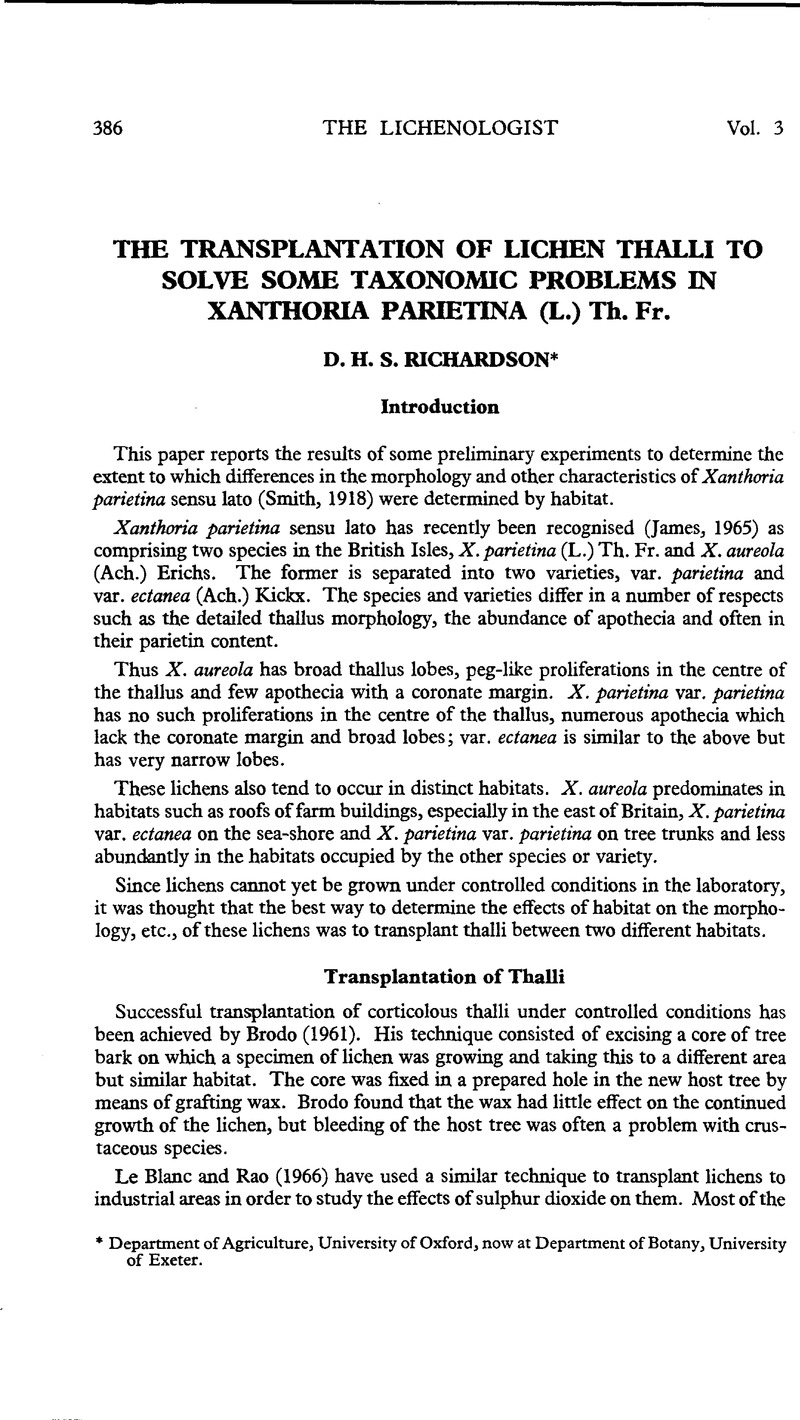Crossref Citations
This article has been cited by the following publications. This list is generated based on data provided by Crossref.
Poelt, Josef
1968.
Fortschritte der Botanik.
p.
276.
Richardson, D.H.S.
1971.
Vol. 4,
Issue. ,
p.
267.
SANTESSON, JOHAN
1973.
The Lichens.
p.
633.
Rundel, Philip W.
1978.
The ecological role of secondary lichen substances.
Biochemical Systematics and Ecology,
Vol. 6,
Issue. 3,
p.
157.
Golojuch, S. Thomas
and
Lawrey, James D.
1988.
QUANTITATIVE VARIATION IN VULPINIC AND PINASTRIC ACIDS PRODUCED BY TUCKERMANNOPSIS PINASTRI (LICHEN‐FORMING ASCOMYCOTINA, PARMELIACEAE).
American Journal of Botany,
Vol. 75,
Issue. 12,
p.
1871.
Farmer, A.M.
Bates, J.W.
and
Bell, J.N.B.
1992.
Acidification Research: Etvaluation and Policy Applications.
Vol. 50,
Issue. ,
p.
295.
HONEGGER, ROSMARIE
1996.
Experimental studies of growth and regenerative capacity in the foliose lichen Xanthoria parietina.
New Phytologist,
Vol. 133,
Issue. 4,
p.
573.
Solhaug, Knut A.
and
Gauslaa, Yngvar
1996.
Parietin, a photoprotective secondary product of the lichen Xanthoria parietina.
Oecologia,
Vol. 108,
Issue. 3,
p.
412.
Swanson, Andrew
and
Fahselt, Dianne
1997.
Effects of ultraviolet on polyphenolics of Umbilicaria americana.
Canadian Journal of Botany,
Vol. 75,
Issue. 2,
p.
284.
Edwards, H.G.M.
Holder, J.M.
and
Wynn-williams, D.D.
1998.
Comparative FT-Raman spectroscopy of Xanthoria lichen-substratum systems from temperate and antarctic habitats.
Soil Biology and Biochemistry,
Vol. 30,
Issue. 14,
p.
1947.
Scherrer, Sandra
and
Honegger, Rosmarie
2003.
Inter‐ and intraspecific variation of homologous hydrophobin (H1) gene sequences amongXanthoriaspp. (lichen‐forming ascomycetes).
New Phytologist,
Vol. 158,
Issue. 2,
p.
375.
Richardson, David H. S.
and
Cameron, Robert P.
2004.
CYANOLICHENS: THEIR RESPONSE TO POLLUTION AND POSSIBLE MANAGEMENT STRATEGIES FOR THEIR CONSERVATION IN NORTHEASTERN NORTH AMERICA.
Northeastern Naturalist,
Vol. 11,
Issue. 1,
p.
1.
Lindblom, Louise
and
Ekman, Stefan
2005.
Molecular evidence supports the distinction between Xanthoria parietina and X. aureola (Teloschistaceae, lichenized Ascomycota).
Mycological Research,
Vol. 109,
Issue. 2,
p.
187.
Stark, Sari
Kytöviita, Minna-Maarit
and
Neumann, Antje B.
2007.
The phenolic compounds in Cladonia lichens are not antimicrobial in soils.
Oecologia,
Vol. 152,
Issue. 2,
p.
299.
Nybakken, Line
Asplund, Johan
Solhaug, Knut Asbjørn
and
Gauslaa, Yngvar
2007.
Forest Successional Stage Affects the Cortical Secondary Chemistry of Three Old Forest Lichens.
Journal of Chemical Ecology,
Vol. 33,
Issue. 8,
p.
1607.
Heim, Amy
and
Lundholm, Jeremy
2013.
Cladonia lichens on extensive green roofs: evapotranspiration, substrate temperature, and albedo.
F1000Research,
Vol. 2,
Issue. ,
p.
274.
Smith, Paul L.
2014.
Lichen translocation with reference to species conservation and habitat restoration.
Symbiosis,
Vol. 62,
Issue. 1,
p.
17.
Heim, Amy
and
Lundholm, Jeremy
2014.
Cladonia lichens on extensive green roofs: evapotranspiration, substrate temperature, and albedo.
F1000Research,
Vol. 2,
Issue. ,
p.
274.
Fortuna, Lorenzo
and
Tretiach, Mauro
2018.
Effects of site-specific climatic conditions on the radial growth of the lichen biomonitor Xanthoria parietina.
Environmental Science and Pollution Research,
Vol. 25,
Issue. 34,
p.
34017.
Pichler, Gregor
Candotto Carniel, Fabio
Muggia, Lucia
Holzinger, Andreas
Tretiach, Mauro
and
Kranner, Ilse
2021.
Enhanced culturing techniques for the mycobiont isolated from the lichen Xanthoria parietina.
Mycological Progress,
Vol. 20,
Issue. 6,
p.
797.



